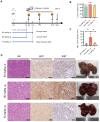18F-5-fluoro-aminosuberic acid PET/CT imaging of oxidative-stress features during the formation of DEN-induced rat hepatocellular carcinoma
- PMID: 39744233
- PMCID: PMC11667236
- DOI: 10.7150/thno.100467
18F-5-fluoro-aminosuberic acid PET/CT imaging of oxidative-stress features during the formation of DEN-induced rat hepatocellular carcinoma
Abstract
Rationale: The role of oxidative stress metabolism during hepatocellular carcinoma (HCC) formation potentially allows for positron emission tomography (PET) imaging of oxidative stress activity for early and precise HCC detection. However, there is currently limited data available on oxidative-stress-related PET imaging for longitudinal monitoring of the pathophysiological changes during HCC formation. This work aimed to explore PET-based longitudinal monitoring of oxidative stress metabolism and determine the sensitivity of [18F]-5-fluoroaminosuberic acid ([18F]FASu) for assessing pathophysiological processes in diethylnitrosamine (DEN) induced rat HCC. Methods: Genomic and clinical data were obtained from the HCC dataset (n = 383) in The Cancer Genome Atlas (TCGA-LIHC) and Gene Expression Omnibus (GEO) datasets. Wistar rats were administered DEN weekly, either by gavage (i.g.) at doses of 10 mg/kg or 80 mg/kg or by intraperitoneal injection (i.p.) at 80 mg/kg, with continuous modeling over a 12-week period followed by 24 weeks of consecutive feeding. PET/CT imaging was conducted at weeks 8, 15, and 21 by tail vein injections of [18F]FASu and [18F]FDG (~3.7 MBq). Finally, contrast-enhanced CT imaging of the nodules was performed at the designed time point. The rats in each group were sacrificed at multiple time points to perform a correlation analysis between PET imaging findings and histological examinations. Results: Bioinformatics analysis revealed that upregulation expression of SLC7A11 in HCC indicates oxidative stress-altered cellular metabolism and allows early detection of HCC formation. By simulating different levels of oxidative stress in DEN-induced rat HCC, the SUVmax of [18F]FASu PET imaging positively correlated with the expression of CD44 and SLC7A11 (r = 0.7913, P < 0.0001; r = 0.7173, P < 0.0001, respectively), which maintain redox homeostasis in the cells. Compared with 18F-fluorodeoxyglucose ([18F]FDG), [18F]FASu PET imaging demonstrated higher sensitivity for HCC diagnosis and enabled the characterization of pathological changes in DEN-induced rat HCC at an early stage. Conclusions: Our findings regarding the oxidative stress characterization of HCC formation in DEN-induced rat models using [18F]FASu PET imaging demonstrated the exciting potential of oxidative-stress-related PET imaging for monitoring the pathophysiological changes during HCC formation.
Keywords: HCC; Oxidative stress; PET imaging; SLC7A11; [18F]FASu.
© The author(s).
Conflict of interest statement
Competing Interests: The authors have declared that no competing interest exists.
Figures






Similar articles
-
Evaluation of 2-[18F]-fluoro-2-deoxy-D-glucose positron emission tomography/computed tomography in rat models with hepatocellular carcinoma with liver cirrhosis.Biomed Mater Eng. 2015;26 Suppl 1:S1669-76. doi: 10.3233/BME-151466. Biomed Mater Eng. 2015. PMID: 26405933
-
18F-FDG PET/CT AS AN ASSESSMENT TOOL OF HEPATOCELLULAR CARCINOMA SECONDARY TO NON-ALCOHOLIC FATTY LIVER DISEASE DEVELOPMENT IN EXPERIMENTAL MODEL.Arq Gastroenterol. 2019 Jan-Mar;56(1):45-50. doi: 10.1590/S0004-2803.201900000-02. Epub 2019 Mar 18. Arq Gastroenterol. 2019. PMID: 31141073
-
Evaluation of diethylnitrosamine- or hepatitis B virus X gene-induced hepatocellular carcinoma with 18F-FDG PET/CT: a preclinical study.Oncol Rep. 2015 Jan;33(1):347-53. doi: 10.3892/or.2014.3575. Epub 2014 Oct 30. Oncol Rep. 2015. PMID: 25371060
-
Cancer Metabolism as a Mechanism of Treatment Resistance and Potential Therapeutic Target in Hepatocellular Carcinoma.Yonsei Med J. 2018 Dec;59(10):1143-1149. doi: 10.3349/ymj.2018.59.10.1143. Yonsei Med J. 2018. PMID: 30450847 Free PMC article. Review.
-
Clinical applications and advances of positron emission tomography with fluorine-18-fluorodeoxyglucose (18F-FDG) in the diagnosis of liver neoplasms.Postgrad Med J. 2008 May;84(991):246-51. doi: 10.1136/pgmj.2007.066589. Postgrad Med J. 2008. PMID: 18508981 Review.
Cited by
-
Electroactive Fe3O4/α-Fe2O3@Au nanocomposites driven label-free electrochemical aptasensor with magnetic self-assembly for rapid quantification of alpha-fetoprotein.Mikrochim Acta. 2025 May 17;192(6):361. doi: 10.1007/s00604-025-07173-2. Mikrochim Acta. 2025. PMID: 40381048
References
-
- Sung H, Ferlay J, Siegel RL, Laversanne M, Soerjomataram I, Jemal A. et al. Global Cancer Statistics 2020: GLOBOCAN Estimates of Incidence and Mortality Worldwide for 36 Cancers in 185 Countries. CA Cancer J Clin. 2021;71:209–49. - PubMed
-
- Sharma B, Martin A, Zerizer I. Positron emission tomography-computed tomography in liver imaging. Semin Ultrasound CT MR. 2013;34:66–80. - PubMed
-
- Castilla-Lievre MA, Franco D, Gervais P, Kuhnast B, Agostini H, Marthey L. et al. Diagnostic value of combining (11)C-choline and (18)F-FDG PET/CT in hepatocellular carcinoma. Eur J Nucl Med Mol Imaging. 2016;43:852–9. - PubMed
-
- Haug AR. Imaging of primary liver tumors with positron-emission tomography. Q J Nucl Med Mol Imaging. 2017;61:292–300. - PubMed
Publication types
MeSH terms
Substances
LinkOut - more resources
Full Text Sources
Medical
Miscellaneous

